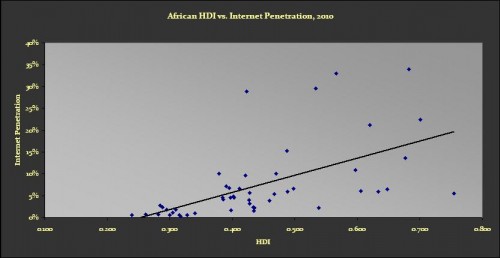Internet Penetration vs. Human Development Index, 2010

Scatter plot of HDI and Internet access using 2010 data. Click to enlarge. Source: Human Development Report 2010. Rep. United Nations, 2010.
Unsurprisingly, there seems to be a direct relationship between UNDP Human Development Index and ITU estimated Internet penetration in Africa. Human Development Index (HDI) is metric used to measure progress in health, education and income over the past 40 years. It’s worth noting that, of African nations, Ethiopia was 11th in HDI improvement since 1970, with Botswana (14), Benin (18) and Burkina Faso (21) also among the world’s 25 “Top Movers.”
- Although Libya has the highest HDI of an African country, its Internet user rate of 6% is substantially below the world average
- None of the bottom 13 nations featured in the HDI report has a penetration rate greater than 3% – a slight improvement over last year’s 2% penetration rate for the same number of bottom nations.
- Nigeria has one of the highest rates of Internet penetration, but lies in the middle of the pack in terms of HDI
Find an Excel document showing both 2009 and 2010 HDI and Internet penetration by African country here.
See last year’s analysis of Internet penetration vs. HDI here.
*Note 1: Seychelles, Somalia, Mayotte, Reunion, St. Helena, Western Sahara, and Eritrea were not included in the UNDP report
*Note 2: Due to the methodological refinements of the HDI formula, which reflect new data availability and changing development patterns, the 2010 rankings are not directly comparable to HDI rankings in earlier Human Development Reports.
*Note 3: Human Development Index (HDI) is calculated based on data from UNDESA (2009d), Barro and Lee (2010), UNESCO Institute for Statistics (2010a), World Bank (2010g) and IMF(2010a).












 Twitter
Twitter Facebook
Facebook Pinterest
Pinterest